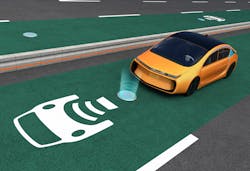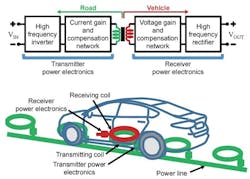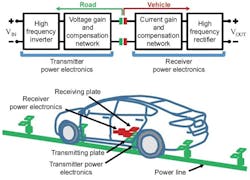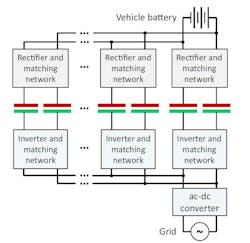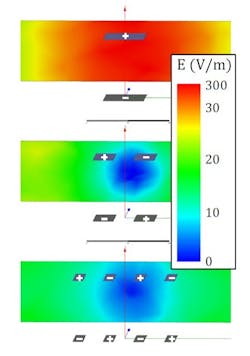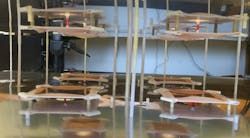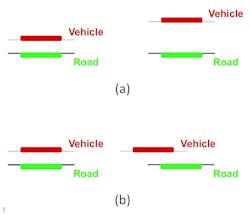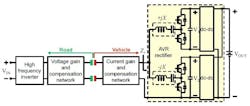Reprinted with permission from Frontiers of Engineering, Reports on Leading-Edge Engineering: Wireless Charging of Electric Vehicles, 2017 by the National Academy of Sciences, Courtesy of the National Academies Press, Washington, D.C.
Click here to obtain the full report or download the free PDF.
Consider a future in which a driverless ridesharing electric vehicle (EV) pulls over as you exit a building, takes you to your destination, and proceeds to drive passenger after passenger without ever needing to stop to recharge its battery. Instead, power generated by nearby wind and solar resources is delivered wirelessly from the roadway to the vehicle while it is in motion.
Not having to stop for recharging will make EVs truly autonomous, and, because the vehicles can thus remain in service for more hours, fewer vehicles will be needed to meet passenger demand. Furthermore, EVs with in-motion (dynamic) wireless charging can have much smaller batteries, an option that can reduce their cost and accelerate adoption.
While the concept of medium-range wireless power transfer (WPT), achieved using near-field (non-radiative) electromagnetic coupling, has existed since the pioneering work of Nikola Tesla (1891) more than a century ago, the technology to enable effective dynamic WPT for EVs is still in its nascent stage. Numerous challenges related to performance, cost, and safety need to be overcome before the vision of wirelessly powered EVs can be realized.
NEAR-FIELD WIRELESS POWER TRANSFER
Near-field WPT systems are of two types: inductive, which use magnetic field coupling between conducting coils, and capacitive, which use electric field coupling between conducting plates to transfer energy (Fig. 1). For medium-range applications (in which the distance between the transmitter and the receiver couplers is comparable to the size of the couplers, as in EV charging), inductive WPT systems have traditionally been preferred.
1. Physical implementation (left) and block diagram representation (right) of two approaches to deliver energy wirelessly to electric vehicles from an electrified roadway: (a) inductive wireless power transfer (WPT) using coils (embedded in the roadway and in the vehicle) that are coupled through magnetic fields, and (b) capacitive WPT using plates coupled through electric fields. In both cases, power electronics (comprising a high-frequency inverter and rectifier with semiconductor devices, and gain and compensation networks with inductors, capacitors, and/or transformers) is the enabling technology.
Inductive WPT Systems
Building on work done for material handling applications during the 1990s (Green and Boys 1994), the past decade has seen tremendous progress in inductive WPT technology for stationary charging of EVs (Bosshard and Kolar 2016). Aftermarket stationary chargers are already available, and some EV manufacturers have announced plans to introduce built-in stationary inductive WPT systems as early as 2018.
However, for magnetic flux guidance and shielding, inductive WPT systems require ferrite cores, making them expensive and bulky. Also, to limit losses in the ferrites, the operating frequencies of these systems are kept under 100 kHz, resulting in large coils and low power transfer densities. The high cost and low power transfer density are particularly problematic for dynamic WPT, as these systems need to have very high power capability to deliver sufficient energy to the vehicle during its very brief time passing over a charging coil.
For these reasons dynamic inductive WPT is yet to become commercially viable, although a few experimental systems have been demonstrated (Choi et al. 2015; Onar et al. 2013).
Capacitive WPT Systems
Capacitive WPT systems have potential advantages over the inductive systems because of the relatively directed nature of electric fields, which reduces the need for electromagnetic field shielding. Also, because capacitive WPT systems do not use ferrites, they can be operated at higher frequencies, allowing them to be smaller and less expensive. Capacitive WPT could thus make dynamic EV charging a reality.
But because of the very small capacitance between the road and vehicle plates, effective power transfer can occur only at very high frequencies, making the design of these systems extremely challenging. With the recent availability of wide-bandgap (gallium nitride [GaN] and silicon carbide [SiC]) power semiconductor devices that enable higher-frequency operation, high-power medium-range capacitive WPT systems are becoming viable (Regensburger et al. 2017; Zhang et al. 2016).
Two major challenges associated with capacitive WPT for EV charging are (1) achieving high-power transfer density at high efficiencies while meeting electromagnetic safety requirements, and (2) maintaining effective power transfer even as the couplers’ relative position changes. These challenges have been a focus of my group’s recent efforts.
ACHIEVING SAFE AND EFFICIENT HIGH-POWER TRANSFER
The size of the couplers in WPT systems can be reduced and the power transfer density increased by designing the systems to operate at higher frequencies. In inductive systems the increase in induced voltage with higher frequency compensates for the reduced mutual inductance of the smaller coils, and in capacitive systems the increase in displacement current with higher frequency compensates for the smaller plates’ lower capacitance. Higher operating frequencies also enable smaller power electronics associated with WPT systems (see Figure 1) thanks to a decrease in energy storage requirements.
But achieving high efficiencies at high switching frequencies is very challenging. And the fringing fields of WPT systems must be within safe levels (as defined by the International Commission on Non-Ionizing Radiation Protection; ICNIRP 1998) in areas occupied by people and animals (e.g., the vehicle cabin and outside the perimeter of the chassis). These requirements for capacitive WPT systems can be met through circuit stages that provide appropriate voltage and current gain (to reduce displacement currents) as well as reactive compensation (Fig. 1). An active area of research is the design of these circuit stages (Lu et al. 2015; Theodoridis 2012).
Multistage Matching Networks
Our work in this area has explored approaches utilizing multistage matching networks that can simultaneously provide gain and compensation (Sinha et al. 2016). We have discovered that, depending on the ratio of the system input and output voltages, there is an optimal number of stages that maximizes efficiency, and we have identified the optimal distribution of gain and compensation among these stages.
To further reduce fringing fields in capacitive WPT systems, various coupler design approaches have been considered. Those that use dielectric materials for field guidance introduce additional losses and have limited success in medium-range applications.
Phased-Array Field Focusing
We have been exploring techniques traditionally used for beamforming in radars and other far-field applications (Hansen 2009). We have developed a nearfield phased-array field-focusing approach that uses multiple phase-shifted capacitive WPT modules to achieve dramatic reductions in fringing fields (Fig. 2). We have shown that a 180°-outphased configuration yields a progressive reduction in fringing electric fields as the number of modules increases (Kumar et al. 2015).
Phased-array field focusing provides opportunities for innovation, for example in the exploration of methods that incorporate parasitic interactions between multiple coupling plates in the design of the matching networks. Such phased-array approaches could also be adapted for inductive WPT to help eliminate ferrites (Waters et al. 2015).
2. Multi-modular near-field phased-array capacitive wireless power transfer (WPT) system: (a) block diagram representation, (b) simulated performance showing fringing field reduction with progressive increase in the number of modules, and (c) photograph of a prototype system. E = electric field strength; V/m = volt per meter.
ACHIEVING VARIABLE COMPENSATION
To achieve effective power transfer, WPT systems need to operate close to the resonant frequency of the resonant tank formed by the reactances (capacitive and inductive) of the coupler and compensating network. However, the coupler reactance depends on the vehicle’s road clearance, and varies as the vehicle moves across the charger (Fig. 3). The drift between resonant and operating frequency causes a reduction in power transfer and WPT system efficiency.
In WPT systems that operate at frequencies below 100 kHz, where bandwidths are not restrictive, the traditional way to deal with variations in coupling is to change the operating frequency to track the resonant frequency (Covic and Boys 2013; Shekhar et al. 2013). But in high-frequency WPT systems the operating frequency must stay within one of the designated, very restrictive industrial, scientific, and medical (ISM) bands (e.g., 6.78 MHz, 13.56 MHz, and 27.12 MHz; FCC 2014).
One solution, employed in low-power inductive WPT systems, is to use a bank of capacitors that can be switched in and out of the compensating network, to keep the resonant frequency roughly unchanged as the transmitter and receiver move relative to each other (Lim et al. 2014). But this is not an effective approach for higher-power WPT systems as the switches have to be much bigger and more expensive to keep the system efficient. This approach is also less suited to capacitive WPT because it requires multiple switchable compensating inductors, which are bigger than capacitors.
Other adaptive impedance matching techniques include the use of saturable and variable inductors (James et al. 2005), but these techniques reduce system efficiency and do not scale well with power. We have developed new high-frequency rectifier and inverter architectures that compensate for coupling variations while operating at fixed frequency and maintaining high efficiency. An example is the active variable reactance (AVR) rectifier shown in Figure 3 (Sinha et al. 2017). By appropriately controlling the output voltages of its two coupled rectifiers, the AVR can provide continuously variable compensation while maintaining optimum soft switching to ensure high efficiency. This compensation architecture ensures that the output power of the WPT system is maintained at a fixed level across wide variations in coupling and is applicable to both capacitive and inductive WPT systems.
3. Coupling variations and an approach to compensate for these variations: (a) variation in coupling due to different vehicle road clearances, (b) variation in coupling due to change in vehicle position as it drives over the charger, and (c) a capacitive wireless power transfer (WPT) system with an active variable reactance (AVR) rectifier that can provide continuously variable compensation by controlling the voltages V1 and V2. jX = tank reactance; Zr = rectifier input impedance.
CONCLUSIONS AND FUTURE DIRECTIONS
High-performance, safe, and cost-effective dynamic electric vehicle charging has the potential to revolutionize road transportation. What combination of capacitive and inductive WPT will enable this revolution is an open question. Both systems offer tremendous opportunities for research, especially in high-frequency power electronics and near-field coupler design. Research is also needed on:
- Health effects of long-term exposure to weak electric and magnetic fields,
- Mechanisms to detect living and foreign objects in the proximity of WPT systems,
- Methods to determine optimal charger power levels and spacing for cost effectiveness,
- Techniques to embed WPT technology in roadways, and
- Approaches to analyze impacts of large-scale WPT system deployment on the electric grid.
The technologies developed for dynamic EV charging are foundational—they can also enable wirelessly powered biomedical implants, humanoid robots, and supersonic hyperloop transport. The technological challenges are exciting and the possibilities endless.
REFERENCES
Bosshard R, Kolar JW. 2016. All-SiC 9.5 kW/dm3 on-board power electronics for 50 kW/85 kHz automotive IPT system. IEEE Journal of Emerging and Selected Topics in Power Electronics 5(1):419–431.
Choi SY, Gu BW, Jeong SY, Rim CT. 2015. Advances in wireless power transfer systems for roadway powered electric vehicles. IEEE Journal of Emerging and Selected Topics in Power Electronics 3(1):18–36.
Covic GA, Boys JT. 2013. Inductive power transfer. Proceedings of the IEEE 101(6):1276–1289.
Davis SC, Williams SE, Boundy RG. 2016. Transportation Energy Data Book, edition 35. Oak Ridge National Laboratory (ORNL).
FCC [Federal Communications Commission]. 2014. Part 15: Radio frequency devices. Electronic Code of Federal Regulations, Title 47: Telecommunications (47CFR15). https://www.fcc.gov/general/rules-regulations-title-47.
Green AW, Boys JT. 1994. 10 kHz inductively coupled power transfer: Concept and control. Proceedings of the IEE International Conference on Power Electronics and Variable-Speed Drives, October 26–28, London.
Hansen RC. 2009. Phased Array Antennas, 2nd ed. Hoboken NJ: John Wiley & Sons.
ICNIRP [International Commission on Non-Ionizing Radiation Protection]. 1998. Guidelines for limiting exposure to time-varying electric, magnetic, and electromagnetic fields (up to 300 GHz).
Health Physics 74(4):494–592.
James J, Boys J, Covic G. 2005. A variable inductor-based tuning method for ICPT pickups. Proceedings of the International Power Engineering Conference (IPEC), November 29–December 2, Singapore.
Kumar A, Pervaiz S, Chang CK, Korhummel S, Popovic Z, Afridi KK. 2015. Investigation of power transfer density enhancement in large air-gap capacitive wireless power transfer systems. Proceedings of the IEEE Wireless Power Transfer Conference (WPTC), May 13–15, Boulder.
Lim Y, Tang H, Lim S, Park J. 2014. An adaptive impedance-matching network based on a Novel capacitor matrix for wireless power transfer. IEEE Transactions on Power Electronics 29(8):4403–4413.
Lu F, Zhang H, Hofmann H, Mi C. 2015. A double-sided LCLC-compensated capacitive power transfer system for electric vehicle charging. IEEE Transactions on Power Electronics 30(11):6011–6014.
Onar OC, Miller JM, Campbell SL, Coomer C, White CP, Seiber LE. 2013. A novel wireless power transfer system for in-motion EV/PHEV charging. Proceedings of the IEEE Applied Power Electronics Conference and Exposition (APEC), March 17–21, Long Beach, CA.
Regensburger B, Kumar A, Sinha S, Doubleday K, Pervaiz S, Popovic Z, Afridi KK. 2017. High performance large air-gap capacitive wireless power transfer system for electric vehicle charging. Proceedings of the IEEE Transportation Electrification Conference & Exposition (ITEC), June 13–15, Chicago.
Shekhar S, Mishra S, Joshi A. 2013. A utility interfaced half-bridge based capacitively coupled power transfer circuit with automatic frequency control. Proceedings of the IEEE Energy Conversion Congress and Exposition (ECCE), September 15–19, Denver.
Sinha S, Kumar A, Pervaiz S, Regensburger B, Afridi KK. 2016. Design of efficient matching networks for capacitive wireless power transfer systems. Proceedings of the IEEE Workshop on Control and Modeling for Power Electronics (COMPEL), June 27–30, Trondheim, Norway.
Sinha S, Kumar A, Afridi KK. 2017. Active variable reactance rectifier: A new approach to compensating for coupling variations in wireless power transfer systems. Proceedings of the IEEE Workshop on Control and Modeling for Power Electronics (COMPEL), July 9–12, Stanford, CA.
Tesla N. 1891. Experiments with alternating currents of very high frequency and their application to methods of artificial illumination. Evening session at Columbia College, June 20, New York.
Theodoridis MP. 2012. Effective capacitive power transfer. IEEE Transactions on Power Electronics 27(12):4906–4913.
Waters BH, Mahoney BJ, Ranganathan V, Smith JR. 2015. Power delivery and leakage field control using an adaptive phased-array wireless power system. IEEE Transactions on Power Electronics 30(11):6298–6309.
Zhang H, Lu F, Hofmann H, Liu W, Mi C. 2016. A four-plate compact capacitive coupler design and LCL-compensated topology for capacitive power transfer in electric vehicle charging application. IEEE Transactions on Power Electronics 31(12):8541–8551.
About the Author
Khurram Afridi
Khurram Afridi is an Assistant Professor of Electrical, Computer and Energy Engineering and the Goh Faculty Fellow at the University of Colorado (CU) Boulder.
